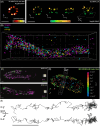MINFLUX nanoscopy: Visualising biological matter at the nanoscale level
- PMID: 38661499
- PMCID: PMC11987580
- DOI: 10.1111/jmi.13306
MINFLUX nanoscopy: Visualising biological matter at the nanoscale level
Abstract
Since its introduction in 2017, MINFLUX nanoscopy has shown that it can visualise fluorescent molecules with an exceptional localisation precision of a few nanometres. In this overview, we provide a brief insight into technical implementations, fluorescent marker developments and biological studies that have been conducted in connection with MINFLUX imaging and tracking. We also formulate ideas on how MINFLUX nanoscopy and derived technologies could influence bioimaging in the future. This insight is intended as a general starting point for an audience looking for a brief overview of MINFLUX nanoscopy from theory to application.
Keywords: MINFLUX; single molecule tracking; super‐resolution microscopy.
© 2024 The Authors. Journal of Microscopy published by John Wiley & Sons Ltd on behalf of Royal Microscopical Society.
Conflict of interest statement
The authors declare no conflict of interest.
Figures



References
-
- Hartschuh, A. , Pedrosa, H. N. , Novotny, L. , & Krauss, T. D. (2003). Simultaneous fluorescence and Raman scattering from single carbon nanotubes. Science, 301(5638), 1354–1356. - PubMed
-
- Renz, M. (2013). Fluorescence microscopy‐a historical and technical perspective. Cytometry A, 83(9), 767–779. - PubMed
-
- Amos, W. B. , & White, J. G. (2003). How the confocal laser scanning microscope entered biological research. Biology of the Cell, 95(6), 335–342. - PubMed
-
- Denk, W. , Strickler, J. H. , & Webb, W. W. (1990). Two‐photon laser scanning fluorescence microscopy. Science, 248(4951), 73–76. - PubMed
Publication types
MeSH terms
Substances
Grants and funding
LinkOut - more resources
Full Text Sources

